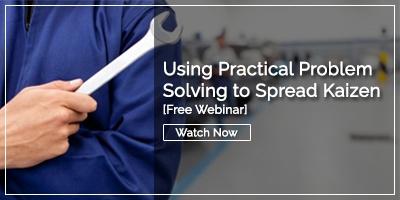 In the webinar series Ask Us Anything, which you can find here, KaiNexus CEO and Co-founder Greg Jacobson and Mark Graban, our Vice-President of Improvement & Innovation Services and founder of LeanBlog.org, answer questions from KaiNexus webinar viewers on video.
In the webinar series Ask Us Anything, which you can find here, KaiNexus CEO and Co-founder Greg Jacobson and Mark Graban, our Vice-President of Improvement & Innovation Services and founder of LeanBlog.org, answer questions from KaiNexus webinar viewers on video.
For those who prefer to catch up on the continuous improvement discussion though the written word, we have summarized a couple of answers from episode 12 of Ask Us Anything here.
Have a question of your own?
Sign up for today's Ask Us Anything webinar and submit your question for Mark and Greg!
Getting Leaders and Executives to Buy-In to Continuous Improvement
Jacobson was the first to try and answer the question, explaining that they could easily spend an hour talking about this single topic, and that KaiNexus has several webinars on this theme alone. To Jacobson, what this question ultimately revolves around is conflict resolution - one of the principles of which is finding a common ground. Just like when speaking about how to engage front line employees, Jacobson suggested that finding a common ground of what frustrates leaders and then working to fix that problem will lead to buy-in.
“What are their goals? What are they trying to achieve this year, this month, over the next five years -- and don’t talk about continuous improvement, just talk about the goals and figuring out how can we move the needle to start accomplishing those goals. What you’ll end up realizing is that they’ll be doing continuous improvement before they even realize it, and you don’t even have to talk about Hoshin, or strategy deployment, or control charts, or A3s. It’s getting that core of improvement science as being part of just what we do versus [saying that] we’re going to do this ‘program’ called Lean, and we know that doesn’t work - it’s more of a lifestyle and it’s a practice instead of something we’re going to start on Monday,” Jacobson said.
Graban agreed with this, adding that continuous improvement, Lean, or Kaizen, or whatever label it’s given, should be a means to an end, not something that’s done because it’s somehow the right thing to do, or because it’s trendy. And the end is, over time, driving sustainable long-term results for the organization, that are not just cost and finance related, but also in safety, quality, customer satisfaction, and employee satisfaction.
“Executives and leaders still set direction, but then we ask employees and managers at different levels to figure out, how are we going to accomplish goals in their local department and organizationally,” Graban said. “One other thing I would add: I think if leaders don’t embrace this approach to continuous improvement... I hear all the time people ask, how do we convince people that it will work? And I say, well, let’s try. Let’s do a small test of change, let’s do a pilot, let’s demonstrate A) people will participate, B) They will keep participating, and C) that it’s going to be driving all sorts of benefits in that small part of the organization, prove that out and then expand.”
“And then I think one of the best ways to continue to make sure that your leaders, once they do the experiment [and] authorize energy be used toward this type of behaviour, make sure they have visibility into the impact,” Jacobson added. “I think it’s something that software really brings to the table to be able to do that, but whether you’re doing it through KaiNexus or Excel spreadsheets, or just on paper, if there’s a different way to improve, to get to the end, by all means, do it.”
Making people understand what the results are is going to be critical to understanding, Jacobson explained, likening it to a sports game in that if you don’t know what the score of the game is, then it’s hard to know if you’re playing the game right.
For more information on this topic, check out this webinar:
What's Your Process for Planning a Kaizen Event?
The last question Jacobson and Graban answered in episode 12 of Ask Us Anything came from April, who asked about the process for planning a kaizen event, and how to determine the scope and goals after clearly defining the problem and business case.
Before answering the question Graban clarified that when he and Jacobson use the term Kaizen, the default meaning they are referring to is small, staff-driven continuous improvement ideas. The phrase “kaizen event” in this way refers to a form of kaizen.
“The kaizen event is usually three to five days, it can be shorter but let’s call it a week-long kaizen event. The work to plan the event is usually greater than the week itself, where people might start eight weeks in advance defining the problem, doing an initial kaizen event charter, forming a team, collecting data, and I think the question about determining the scope and goals is an iterative discussion,” Mark said. “So it’s by no means a situation where you plan and have the week scripted and you know exactly what’s going to happen, that wouldn’t be a good event. But you’ve certainly done the work to make sure you’ve got what seems a reasonable scope, that you’ve got who you think are the right people involved, and you’ve got the ability to actually go pilot some changes instead of spending a week coming up with a to-do list.”
Jacobson pointed out that a lot of the magic of a kaizen event happens because people are in a room together with some butcher paper or they are in the Gemba rolling up their sleeves and figuring out what the process is.
“Documenting what happens there is probably the only way the KaiNexus platform’s going to be used during the event because the magic really happens when people are talking and conversing,” Jacobson said. “What we see is that people that manage Kaizen events in KaiNexus are able to make sure that all those improvements end up getting completed.”
Jacobson cautioned that using kaizen events has been proven not to create a culture of continuous improvement. When he was just beginning to learn about Kaizen, long before starting KaiNexus, Jacobson recalls that his initial take was that there was nothing continuous about events, and since then in his conversations with experts like Graban he has learned the popularity of events has really been a manifestation of consultant culture.
“It’s very easy for a consultant to come on site for a week and really help spur and lead that process on. That’s not to decrease the value of events, events certainly have their place, they’re a very effective top-down mechanism. But we’ve seen over, and over, and over, and we actually have some great charts and data to show this in KaiNexus, where that episodic nature of the event and it then not leading to a culture of continuous improvement,” Jacobson explained.
Graban added that when kaizen events first took place in the United States, then called kaizen blitzes, their intent was to demonstrate that improvement was possible, and spur on and inspire ongoing continuous improvement.
“That would be, I think, the ideal situation... You do some events – and you’re going to need events, I think, to solve relatively large systemic problems – but you should also be doing ongoing continuous improvement,” Graban said. “This all ties together – big improvement, small improvement, events, continuous improvement, episodic improvement, it can all coexist. The last point I’ll make is it’s all PDCA, or PDSA (Plan, Do Check, Act); it’s all in that same style.”
For a detailed deep dive into kaizen events, Graban recommend The Kaizen Event Planner by Karen Martin and Mike Osterling. You can find out more about the book at www.ksmartin.com where you’ll also find some more free resources on the topic.





Add a Comment